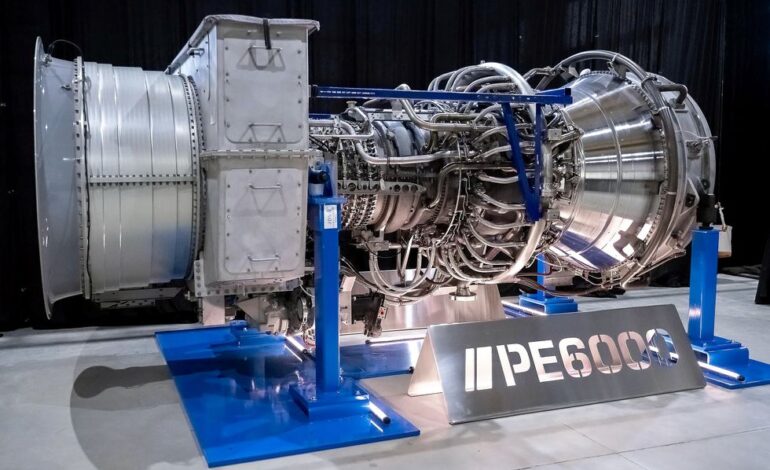Data Centers Turn to Recycled Aircraft Engines for Power Solutions

Data center developers are facing significant power constraints as they accelerate the construction of larger facilities to harness the potential of generative AI. Traditionally, these data centers would connect to the electrical grid or establish onsite power plants. However, they are now encountering substantial delays in securing natural gas turbines and obtaining grid electricity.
At the recent Data Center World Power show in San Antonio in October 2025, ProEnergy, a natural-gas power provider, introduced a novel solution: repurposed aviation engines. According to Landon Tessmer, Vice President of Commercial Operations at ProEnergy, several data centers are utilizing the company’s PE6000 gas turbines to meet their energy demands during both construction and the initial years of operation. When grid power becomes available, these turbines can either serve as backup systems, supplement the grid, or be sold to local utilities.
“We have sold 21 gas turbines for two data-center projects amounting to more than 1 gigawatt (GW),” Tessmer stated. “Both projects are expected to provide bridging power for five to seven years, which is when they expect to have grid interconnection and no longer need permanent behind-the-meter generation.”
Innovative Power Solutions with Aeroderivative Turbines
The practice of converting successful aircraft engines for stationary electric-power generation is well-established among gas-turbine original equipment manufacturers (OEMs) like GE Vernova and Siemens Energy. These aeroderivative gas turbines are lighter, smaller, and easier to maintain compared to traditional heavy-frame models.
“It takes a lot to industrialize an aviation engine and make it generate power,” said Mark Axford, President of Axford Turbine Consultants. An example is GE Vernova’s LM6000 gas turbine, derived from the widely used CF6-80C2 turbofan engine. Released in 1985, the CF6-80C2 was adapted for power generation through modifications, including an expanded turbine section and new controls.
Demand for gas turbines has surged, but supply is constrained. Paul Browning, CEO of Generative Power Solutions, expressed concern, stating, “There just aren’t enough gas turbines to go around and the problem is probably going to get worse.” Currently, potential buyers of the LM6000 may face a waiting list of three to five years. In contrast, Tessmer noted that a PE6000 can be delivered by 2027.
Repurposed Engines Meet Growing Data Center Needs
ProEnergy’s approach involves buying and overhauling used CF6-80C2 engine cores, pairing them with newly manufactured parts. After assembly and rigorous testing, these refurbished engines can produce 48 megawatts (MW), sufficient to power a small to medium-sized data center or a community of approximately 20,000 to 40,000 households. With an estimated 1,000 aircraft engines projected to be retired in the next decade, the supply appears promising.
Larger data centers, however, may require over 100 MW, with some of the latest AI-focused facilities exceeding 1 GW. ProEnergy performs thorough overhauls, returning engines to as-new condition by disassembling, cleaning, inspecting, and repairing or replacing parts as necessary.
ProEnergy’s PE6000 turbines are designed to run on natural gas and can be operational within five minutes. In the event of maintenance needs, a turbine can be replaced with a spare in under 72 hours. Emissions from these turbines average 2.5 parts per million for nitrogen oxides, significantly below the regulatory thresholds set by the EPA.
The popularity of aeroderivative turbines is driven by various factors, including the rapid growth of data centers and the lengthy wait for grid connections, which often face regulatory hurdles. “Aeroderivative gas turbines are gaining ground as a bridging technology that runs behind the meter until the utility is able to supply grid power,” Tessmer explained. He has seen permitting delays extend to eight to ten years, underscoring the need for alternative power solutions.
As the demand for data centers continues to escalate, and if grid connection times remain lengthy, the need for bridging power through repurposed aviation engines could become essential for the expansion of AI infrastructure.






